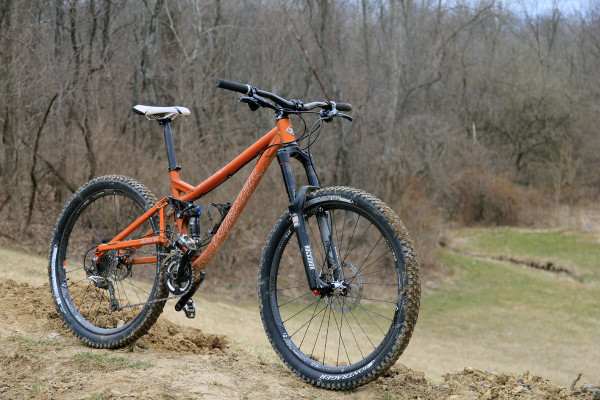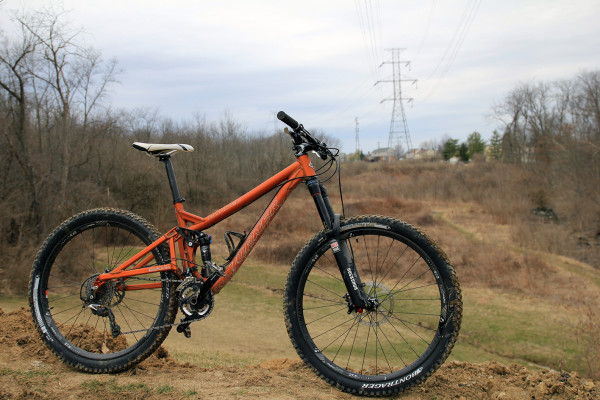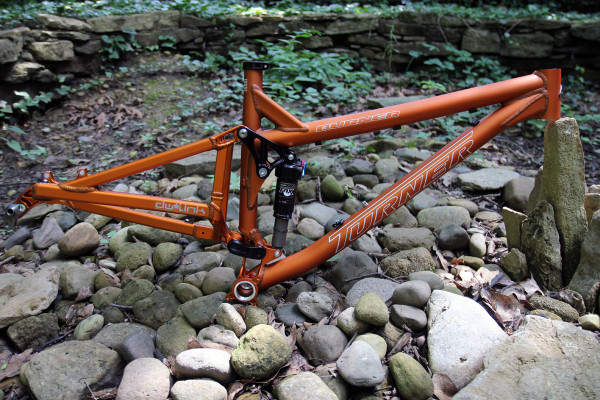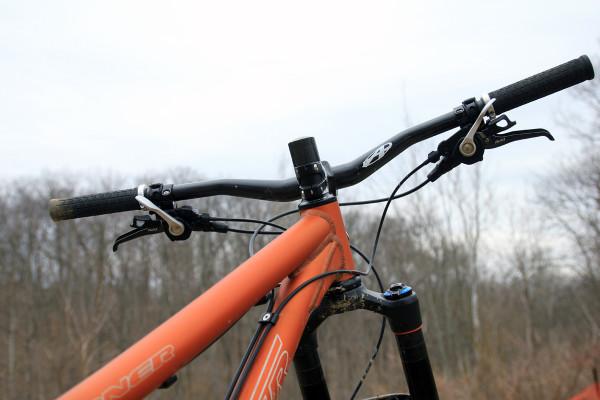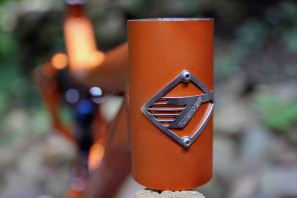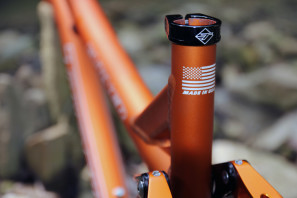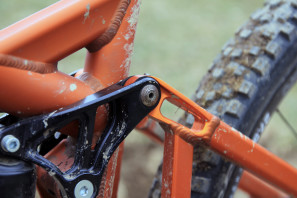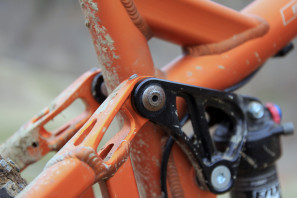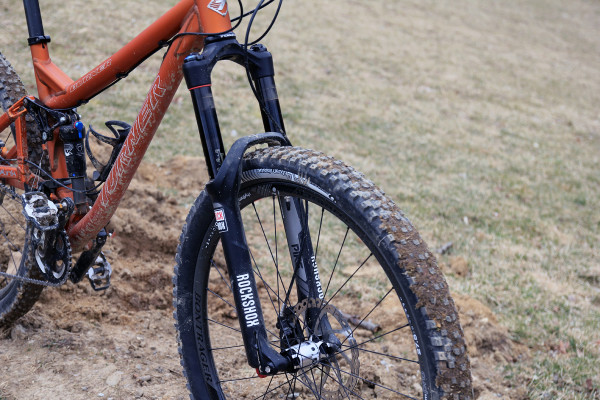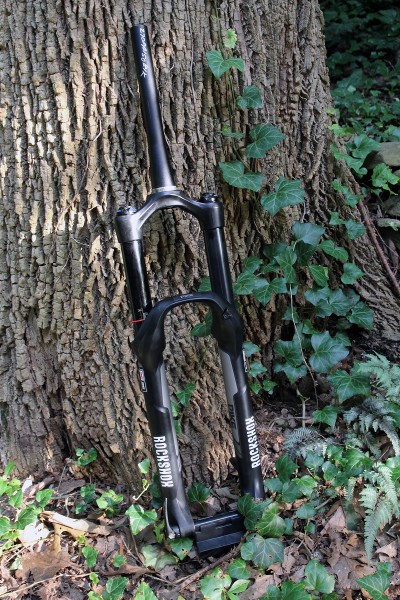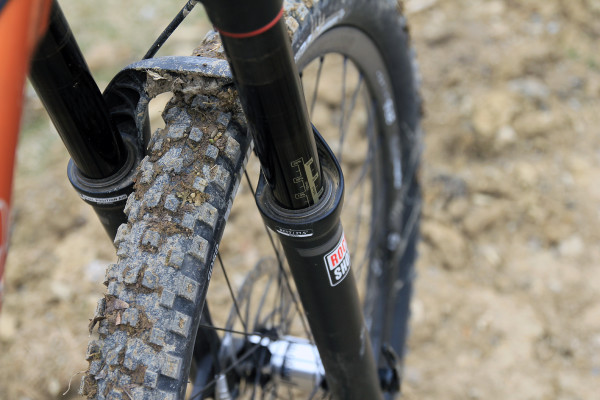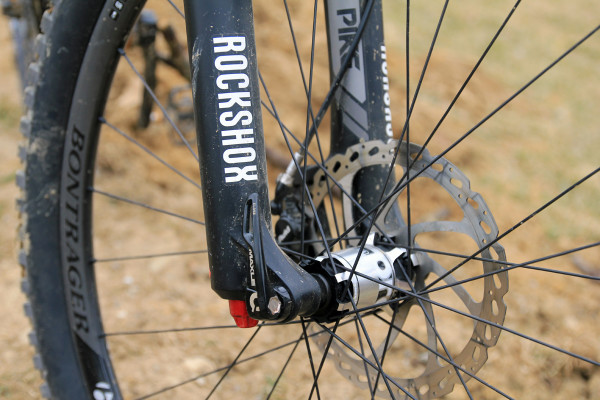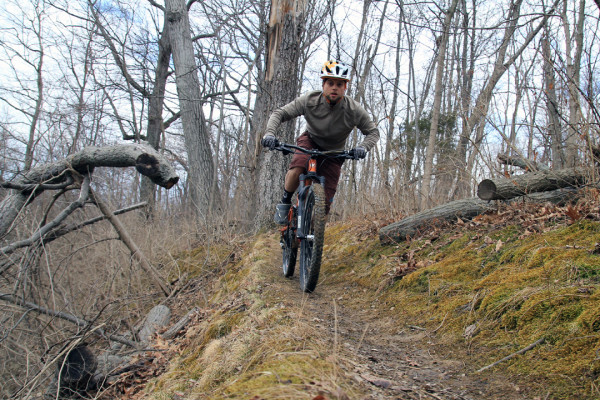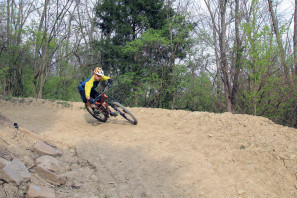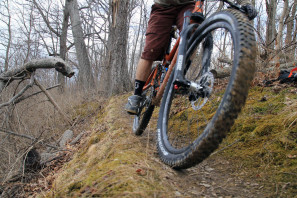When the Turner Burner and RockShox Pike were first introduced, mountain biking was very different than it is today. Hell, mountain biking now is radically different than it was just a few years ago, but in the case of the Turner Burner, full suspension bikes were similar to what fat bike full suspension bikes are today. At a time where hard tails were the norm, Dave Turner took a chance on a 2.75” travel full suspension frame that was raced under some of the nation’s top pros. From there the frame took off, eventually gaining the name Burner and an optional 3.6” travel “DH” rocker link for the big hit crowd.
Since then the Burner has been in and out of the lineup leading up to the version you see here today. For such a small company, Turner has always been willing to try out new technology, and for the rebirth of the Burner, Dave thought the 650b wheel would be a perfect fit. Smaller and lighter than comparable 29” wheels, 650b would retain the Burner’s playful past yet place it out front of the oncoming tidal wave of 27.5” bikes. Designed to be a “quiver killer,” the Burner had to do everything, and do everything well.
The original RockShox Pike has a similar story, produced in a time where longer travel trail or All Mountain bikes were just getting their legs. More than that, the Pike boasted versatility with a 20mm thru axle and a burly chassis that led to a number of more aggressive riders looking to put them on the front of their dirt jumpers and slopestyle bikes – even though that term hadn’t really been invented yet. Sure, the very first Pike had some teething problems, but it set a precedent as a light weight, capable, do-everything type of fork.
Now, the Pike has also been reintroduced in a 650b version (as well as 26” and 29”) at a perfect time to take advantage of the current Enduro trend. Even though Enduro wasn’t even a buzz word when it was first introduced, the Pike was bred for it then, and embodies the term more than ever now.
What are the Turner Burner and Pike like to live with for a season? Find out next…
There is a lot to be said about the Tuner Burner frame – 650b, made in the US aluminum, balanced DW link suspension, 44mm head tube, post mount disc brakes with replaceable threaded inserts, Zerk fittings for greasing the suspension pivots, custom external cable routing clamps, just about every inch of the bike has been carefully thought out in a way that makes the frame feel like an investment rather than the latest disposable bike. Obviously, that’s a big claim, but the Burner really does have a feel of quality and finish that is refreshing. The seat tube is perfectly honed, the post mounts for the brakes are properly faced as is the threaded bottom bracket, and touches like the Zerk fittings on all of the pivots show that future maintenance is a forethought, not an afterthought.
Could the Burner be made lighter and out of carbon? Looking at the Turner Czar that answer would be yes, but after riding and living with the Burner for a while I’m not sure I would want that. Just under 7 pounds for the frame (6.97 with axle to be exact), the Burner is on the heavy side for a 140mm travel bike but with an XT level 2x build and high end wheels, you’ll be in the neighborhood of 26-28 lbs which is plenty light for a 140/150mm travel bike with an aluminum frame. If anything, my time on the Burner has taught me that high end carbon wheels like ENVEs or Bontrager Rhythm Pro Carbons seem to make a bigger difference than a carbon frame – the ride quality is improved, the lighter weight makes the wheels quicker to accelerate, and the stiffness seems to help everywhere. However, during the review of the Burner both aluminum and carbon wheels were tested to make sure they didn’t skew the result. They didn’t. The Burner was still great.
For a bike with 140mm of rear travel, the Burner feels both XC efficient and Enduro ready all at once. If you ask Dave Turner, that’s exactly what he wanted out of the Burner – a bike that you could buy and ride just about everything. Based on my experience that’s pretty close to the truth – from gnarly DH runs and flow trails with high speed jumps to just recently putting it on the podium during an XC TT (and taking the only KOM on course). The Burner may be as close as you can get to a “jack of all trades” bike today. Our test bike included the standard Fox Float CTD rear shock that most of the time was left in the Trail position. The DW-Link suspension is extremely efficient, but the descend mode left the suspension a little too active for most riding. In this case I feel that the CTD Adjust shock would be a worthwhile upgrade so you could fine tune the trail setting, but as it was there were really no complaints out of the rear end. Personally, I also feel that the Burner climbs better when seated, but then I climb better when seated so it makes sense. On ripping down hills the DW Link kept the shock from wallowing in the travel and remained composed off jumps and through high speed rock gardens.
Sizing wise, the medium 17″ frame fit my 5’8″ needs perfectly. Often an issue on many of my test bikes, the short head tube allows for the handlebar to be properly low, while the seatube has enough room for me to install a longer dropper post. All of these issues are reasons why I think I will always gravitate to 27.5″ wheels when it comes to full suspension bikes, but the Turner fits among the best.
Is it perfect? Things rarely are, but it is close. There was only one real issue I ran into during testing – two corroded bolts. Fortunately, as you would expect from a bike of this caliber, Dave is already on the corrosion issue. When we asked him about the bolts he told us that they are custom fasteners unlike some of the others in the system which are standard. The shop that produced them didn’t plate them correctly, so they stand to corrode over time. The fix is simple – shoot Turner an email and they will send you new bolts. Problem solved.
As it turns out, the Pike RCT3 Dual Position Air was a perfect match for the Burner frame. Combined with the DW-link suspension, the Pike offered plush travel when you wanted it and impressively controlled mid stroke and compression when you didn’t. Most of the Pike’s incredible performance can be attributed to the new Charger damper – a drastic departure from the Motion and Mission control dampers of previous years. We all know that RockShox is not the first company to use a sealed, bled damping cartridge with an expandable bladder, but RockShox did an impressive job with their first attempt. Using an extruded bladder which expands under compression, the system is designed to be durable for seasons on end while offering improved damping performance thanks to the exclusion of air from the system. The Charger damper also includes their new Rapid Recovery DIG rebound circuit which causes the wheel to bounce back after rapid hits preventing the fork from packing up. The DIG valve causes rebound oil flow to be slower at low speeds but increases as the impact speed picks up. This is what keeps the fork from packing up on repeated, fast hits. Packaged with adjustable rebound, low speed compression, and pro-pedal and lockout settings, you have a fork that is actually quite tunable at your fingertips. Even further tuning is available internally with internal travel adjustment plus the ability to fine tune the air spring with RockShox’ Bottomless Tokens.
Our test fork was the RCT3 Dual Position air which fortunately is nothing like the Air U-turn of the original Pike. The flick of a knob is all it takes for the travel (in this case, 150mm) to drop down 30mm to lower the front end for climbing. Honestly, on the Burner a 30mm decrease is a lot so I only used the DPA when climbing, but I was surprised at how much it was used. A lot of our trails feature very steep road or trail climbs where the travel adjust can really help to keep the front end from wandering. The travel adjust was always quick and painless, yet the fork continued to function well in the lower setting. Otherwise, on grades more often found on mountain bike trails, the Burner/Pike combo is an impressive climber without touching the travel adjust with its 67 degree head angle and 73 degree seat tube angle.
The improved damping technology on the fork is great, but when riders at the trail ask me what I think about the Pike, the first thing that comes to mind is how plush the fork manages to be while still riding high in the travel when you need it. Quite possibly one of the smoothest forks in the inital travel that I’ve used, even after a full season of abuse without any service it’s still got that magic feeling. If you ask RockShox, part of that feeling is due to their new single lip seals which are possible thanks to the sealed damping cartridge. Since the seals only have to keep the internals clean rather than keep the damping oil in, they inherently offer less stiction when combined with the black hard ano stanchion coating.
If all of that wasn’t enough, then there is the new chassis which bumps up the stiffness with 35mm stanchions and a redesigned, asymmetrical lower. As stiff as the Pike is, you would never guess it weighs in at 4.32 lbs for a 27.5” RCT3 DPA fork with an uncut steerer and the new Maxxle Lite. Thanks to increased material on the disc side of the fork, even when running big rotors you can clamp down on the brakes as hard as you like while maintaining composure at the front end. Fans of the 20mm axle were disappointed when the new Pike was released with only a 15mm option, but there really is no need for disappointment. The Pike chassis is plenty stiff, and most wheel manufacturers offer 15mm adapter kits for their 20mm wheels. Speaking of the 15mm Maxxle Lite, it in itself is a big improvement with a simpler operation that is lighter, and so far just as, if not more, durable.
The Pike is really, really good and at this point is the new standard bearer for all mountain performance.
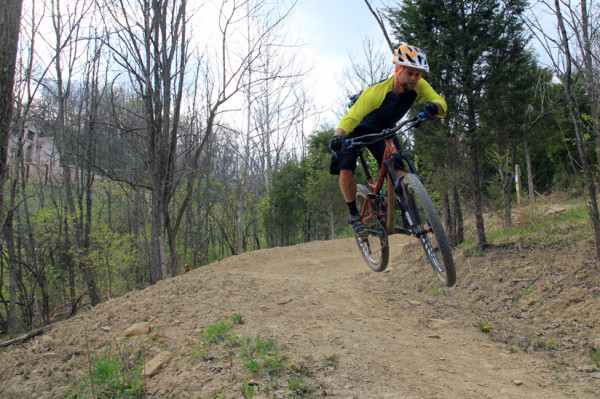
On the trail, the combination of the Burner and the Pike is probably my favorite set up yet. I don’t think I’ve ever been so immediately comfortable on a bike regardless of discipline. Going into the test I wasn’t sure how switching back to an aluminum mountain bike would be – so many of the bikes we test lately are all carbon fiber. Let’s just say that the Turner proves that aluminum is still a viable material, especially in the hands of the experts. At $2,195 for the frame you may be thinking it’s in the carbon realm, but the fact that it is hand made by Zen Bicycle Fabrication combined with the unbeatable performance makes it completely worth it.
When combined with the Pike (highly recommended at 150mm), the Burner really is a competent all-rounder. If you were looking for one bike to ride it all, I would not hesitate to recommend the Turner Burner/ Pike RCT3 DPA combo. Both these products are definitely worth the hype, and easily gain our highest rating.
